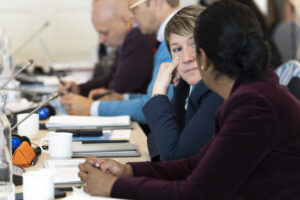Digital inclusion in peace processes – no silver bullet, but a major opportunity
Digital inclusion is paving the way for women and other politically marginalized groups to participate in peace processes. Digital platforms have the potential to foster inclusivity by enabling the participation of those who are unable to join physical meetings. In many conflict settings, the movement of women, youth, or people with disabilities is restricted due to security or cultural reasons, and hence other means for participation need to be explored. However, digital technologies provide no silver bullet, and mitigating their risks requires careful context analysis and process design.

The UN High-Level Seminar on Gender and Inclusive Mediation Strategies was organised in Porvoo, Finland, in May 2023. Photo: Maria Santto/CMI
Digital platforms provide new avenues for inclusion
Women remain underrepresented in peace processes, and even when they are included, they may have difficulties attending in-person meetings. Digital inclusion offers avenues for a wider representation of people, views, and interests in peacemaking.
Digital inclusion in peace processes was the topic of one of the sessions during the UN High-Level Seminar on Gender and Inclusive Mediation Strategies organised in May 2023. During the session, some 30 senior peace mediation professionals and practitioners gathered to discuss the opportunities and caveats related to digital inclusion.
Strategic purpose of digital inclusion rather than digi-excitement
One of the core purposes of digital inclusion in peace processes is related to increased legitimacy and political support, as digital tools allow for wider participation and a larger number and variety of voices to be heard. This, in turn, can increase citizens’ ownership of the process. Meetings, consultations and other participatory processes using easy and widely available technological platforms such as Zoom, Facebook, and WhatsApp make participation easier for those who have often been excluded.
Helena Puig Larrauri, a Senior Digital Technologies Adviser, suggests that each process should start by considering the strategic purpose of digital inclusion in peacemaking rather than excitement over new digital tools.
Digital inclusion can contribute to strengthening the role of women, youth, and marginalized groups through their participation in a peace process. This can have a transforming effect on community relations. It can help to protect those groups in an ongoing peace process through, for example, data collection and reporting mechanisms on gender-based violence.
Digital technologies offer various functions for inclusive peacemaking. Their utility is often found in gathering, analysing and disseminating relevant data. For strategic communications, digital technologies offer tools to amplify and diversify messages. Additionally, digital platforms can connect diverse actors and enable collaboration between them.

Photo: Maria Santto/CMI
Mitigating risks by careful process design
“We must remember that using digital tools to increase inclusion also comes with limitations and challenges,” says CMI’s Head of Women in Peacemaking and Digital Peacemaking, Johanna Poutanen. “Weak information and communications technology infrastructures, high mobile data costs and lack of network access mean that not everyone can participate through digital tools. Unequal access to and use of digital tools may lead to biases in representation.”
Globally women are less likely than men to have access to mobile phones or the internet. Thus, women’s participation through online tools remains lower than that of men.
Security concerns also affect participation, as women are more likely than men to experience online violence. In fact, 38 per cent of women globally who use the internet have experienced online violence, and women in public and political roles are at increased risk.
Social media illustrates the opportunities and risks related to digital tools. On one hand, social media remains an important channel for hearing new and alternative views from a broader range of stakeholders. Analysis of social media content helps to identify which topics may lead to online harassment and thus require attention and action to be addressed.
However, the ratio of male and female users varies drastically between different social media platforms and between countries. Social media data requires analysis and expertise from those using it to avoid misrepresentation of views. Overall, any use of digital tools should be preceded by a careful analysis of the digital landscape.
The risks can and should be mitigated in order to realize the potential that digital tools offer for fostering broader participation. Risks are best minimized by using a hybrid approach, which consists of using the strengths of both digital and conventional forms of inclusion. Careful context analysis and evaluation of different options help to identify the most appropriate tools and modes of participation for each context.
“Training women and women’s groups to use digital technology improves their chances for informed participation and contributes to their empowerment within and beyond a peace process,” says Torunn L. Tryggestad, Director of the PRIO Centre on Gender, Peace and Security.
The 12th UN High-Level Seminar on Gender and Inclusive Mediation Strategies was organised in Porvoo, Finland on 9-11 May in partnership with CMI – Martti Ahtisaari Peace Foundation, Peace Research Institute Oslo (PRIO), and United Nations Department of Political and Peacebuilding Affairs (UN DPPA) with support of Ministry for Foreign Affairs of Finland.